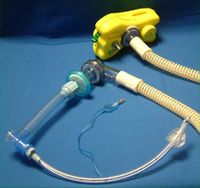Difference between revisions of "Pneupac VR1 Ventilator"
Jump to navigation
Jump to search
Mfrdmanager (talk | contribs) |
Mfrdmanager (talk | contribs) |
||
| (5 intermediate revisions by the same user not shown) | |||
| Line 1: | Line 1: | ||
==Procedure Guidelines== | ==Procedure Guidelines== | ||
===9.01 Pneupac VR1 Ventilator=== | ===9.01 Pneupac VR1 Ventilator=== | ||
| − | + | ||
====INDICATIONS:==== | ====INDICATIONS:==== | ||
Latest revision as of 11:03, 10 February 2018
Contents
Procedure Guidelines
9.01 Pneupac VR1 Ventilator
INDICATIONS:
- To provide ventilatory support in the intubated adult and pediatric patients during transport.
- To assist ventilations in the intubated medical patient.
CONTRAINDICATIONS:
- Trauma patients.
- Patients (under 22lbs./10kg).
EQUIPMENT:
- Oxygen supply with greater than 500 psi.
- Stethoscope.
- Bag Valve Mask for ventilatory backup.
- Suction on stand-by.
PROCEDURE:
- Connect the oxygen hose to the device inlet connection and secure it firmly.
- Set the tidal volume and frequency at the detent position 600mL/12BPM using the rotary control.
- Select manual (MAN) mode using the mode selector.
- Select 100% O2 oxygen concentration with the Airmix switch (if fitted).
- Connect the required patient circuit, mask or airway to the patient outlet.
- Connect the probe on the oxygen hose to an appropriate oxygen outlet or portable oxygen supply.
- NOTE: The gas source must be capable of maintaining a pressure of at least 305 kPa (≈3 bar) whilst delivering a flow of 130 L/min.
- If connected to a cylinder regulator, turn on cylinder valve slowly.
- Rotate the mode selector to AUTO, the device should commence cycling.
- Occlude the output on the patient valve and check that the audible alarm sounds. Check that the device cycles regularly about every 5 seconds.
- Check demand system (if fitted) as follows:-
- ensure the VR1 is set to AUTO and the rotary control is set to the detent position (600mL, 12 BPM). Also ensure that a mask is fitted to the patient valve of the VR1.
- during the second half of the expiratory phase of the ventilator, breath through the face mask in a normal manner.
- continue to breathe in this manner for 2-3 breaths. The automatic cycling of the ventilator will stop.
- stop breathing through the face mask and the ventilator will start its automatic cycling after a short period.
- Set the rotary control to the extremes of its range. By listening to the device and oxygen flow, check that the device is responding to the control and that no irregularities of performance can be discerned. 504-2105 3-4
- Select manual (MAN) mode using the mode selector.
- Depress the VENT button and listen for flow whilst held, up to the duration set by the position of the rotary control.
- Move the omni-directional lever positioned at the bottom of the assembly and listen for flow whilst held, up to the duration set by the position of the rotary control.
- For further explanation of the manual (MAN) mode see Section 3. 2. 5.
- Reset the rotary control to child, mode selector to MAN and 100% O2 oxygen concentration with the Airmix switch (if fitted).
MONITOR:
- Assess the following parameters immediately after connecting the patient to the ventilator:
- Breaths Per Minute (BPM), adjust the BPM control knob to maintain an adequate ventilator rate. Average adult settings are greater than or equal to 12 BPM.
- Tidal Volume, adjust for adequate bilateral chest rise and fall to maintain an adequate ventilatory depth. Average adult settings are between 400 to 1,000 ml.
- Auscultate for the presence of bilateral breath sounds and the absence of abdominal sounds.
- Reassess and document breath sounds every 10 minutes or when change in the patient’s chief complaint, level of consciousness, airway, breathing, circulation, and vital signs to ensure that endotracheal tube is still in proper position.
